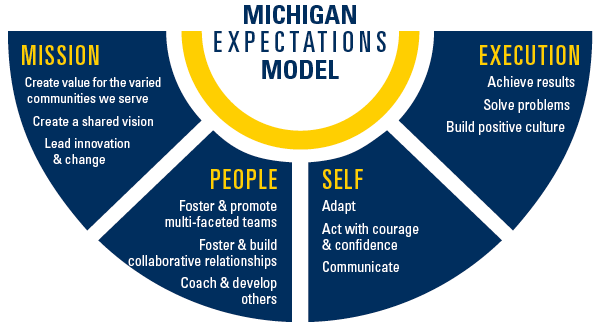The Michigan Expectations Model (MEM) identifies 12 benchmark behavioral standards that all university faculty and staff should demonstrate. The goals of the MEM are to support our shared mission and equip faculty and staff with an understanding of the behavioral expectations needed for success at the University of Michigan.
These behavior standards, termed expectations, will be referenced and used in a variety of ways, including customer care, hiring, professional development and daily conduct.
The model is a framework for development and performance management. It is organized into four domains, each with a set of three related expectations:
Mission
- Create value for the varied communities we serve
- Create a shared vision
- Lead innovation and change
People
- Foster and promote multi-faceted teams
- Foster and build collaborative relationships
- Coach and develop others
Self
- Adapt
- Act with courage and confidence
- Communicate
Execution
- Achieve results
- Solve problems
- Build positive culture
Each faculty and staff member is expected to apply the skills, principles and behaviors of the Michigan Expectations Model and demonstrate personal leadership and responsibility.
Given the diverse nature of our work, this framework can be adapted for the unique needs of any unit, department or school. An individual's development path will vary depending on their current state of acquired skills, experience and breadth of responsibility.
The model is further broken down by behaviors for each of the following employee roles:
- Member of a Team (responsible for the delivery of services to your stakeholders often in partnership with others)
- Leading a Team (coordination of the efforts of others in the delivery of services and mission-related activities to stakeholders)
- Leading Multiple Teams (responsible for the direct implementation of strategies that support organizational goals and mission-related activities)
- Leading the Organization (set organizational direction and have responsibility for management and stewardship of the organization)
The behaviors within each role build upon each other as one moves up within the organization. For example, someone in the Leading Multiple Teams role should be proficient in behaviors for the Member of a Team and Leading a Team roles in addition to those in the Leading Multiple Teams role.
